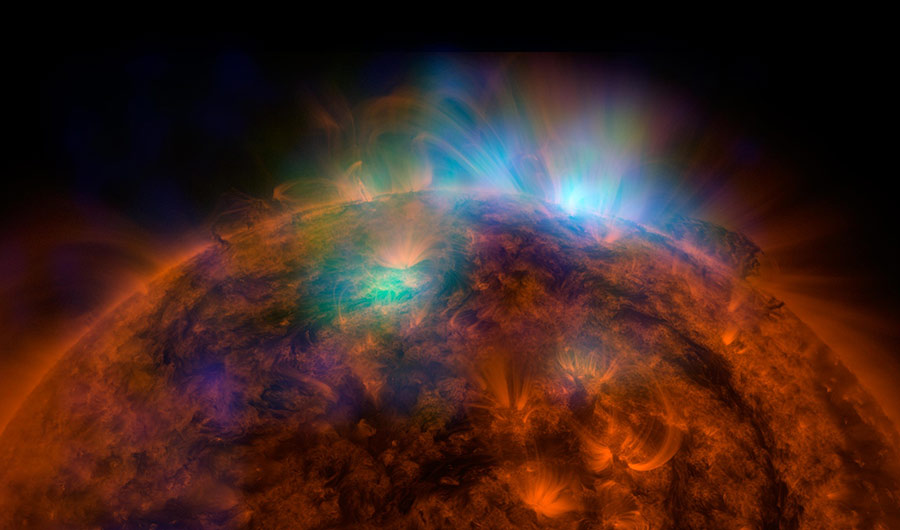Reports of Universe's Fine-Tuning May Be Exaggerated
(Inside Science) -- In their 1994 song "Why does the sun shine?" the rock band They Might be Giants sings, "Hydrogen is built into helium at a temperature of millions of degrees."
What the band left out was deuterium, the stepping stone stars use to get from hydrogen to helium. Most physicists believe that deuterium as we know it is essential to stars' ability to shine, and thus to the existence of life itself. But a pair of recent papers throw that long-held assumption into question.
Stars begin life as hot plasmas made mostly of hydrogen, essentially a churning soup of protons -- subatomic particles with a positive charge -- and electrons, negatively charged particles. Deuterium forms when two protons smash into each other at high energies, one converts into an uncharged neutron, and the two stick together through the process of nuclear fusion. From there, a collision with a third proton yields helium. Each step releases energy, and some of that energy eventually warms the Earth and directly or indirectly powers nearly all of its life, including us.
There's a second reason why deuterium is essential to life. After using up their hydrogen, stars fuse helium into carbon and other heavier elements that all known living things are made of. So if stars glowed but had no way to produce helium, life, it seems, would not exist.
This leads to a mystery that has puzzled physicists: The strong nuclear force that holds subatomic particles together seems to have exactly the right strength to make stars glow but not burn out too fast, giving life time to evolve on planets. Make the force a little stronger, and two protons can also stick together, causing stars to burn out so fast that life wouldn't have time to evolve on planets, argued Freeman Dyson of the Institute for Advanced Studies in Princeton, New Jersey in 1971 in Scientific American. Make it a little weaker and deuterium falls apart, leaving an inert lump of gas incapable of powering life, others showed in follow-up works. "This 'nuclear free' universe would resemble our actual universe only to the extent that -- for instance -- a marble statue resembles a real human," wrote Martin Rees, an astrophysicist at the University of Cambridge.
The universe with an alternate tuning
Physical laws that seem exquisitely "fine-tuned" for complex life runs counter to physicists' intuition that the universe has no reason to favor such laws over the vastly larger set of possibilities that don't support such life. To explain this fine-tuning, some physicists invoke hypotheses such as the multiverse, which posits a large number of universes with different physical laws. We, not surprisingly, would find ourselves in one that can support complex life.
But lately some physicists have been asking a different question: Is the strong force actually fine-tuned at all?
A crack in the argument appeared in 2015, when Luke Barnes at the University of Sydney in Australia showed in a computer simulation that Dyson's "diproton disaster" might not be as disastrous as he had thought. Stars in a universe where the strong force is stronger and protons bind can still burn for millions of years, Barnes found, potentially long enough for life to evolve.
In a study published in April in the journal Astroparticle Physics, physicists Fred Adams and Evan Grohs of the University of Michigan questioned the opposite notion, that stars won't produce energy in a universe where the strong force is so weak that even deuterium can't bind. They ran complex computer simulations of stars' formation and evolution, varying parameters such as a star's mass, temperature and composition.
They found that even if deuterium falls apart almost as soon as it forms, there are three ways stars could still produce energy over long periods. One, as stars condense due to gravity, they heat up. Large-enough stars will heat up enough to glow and eventually generate fusion reactions that don't depend on deuterium, yet that could produce the energy and the elements needed for life.
The second process relies on the fact that stars also contain smaller amounts of carbon produced in previous generations of stars that exploded as supernovas. In Adams and Grohs' simulations, stars with enough carbon could sustain a cycle of fusion reactions that produce energy without deuterium. (Adams admitted this cycle could not have powered the universe's first stars, which began as entirely hydrogen.)
The third possibility is the most novel, Adams said. Even if deuterium were unstable with a weaker strong force, it would still form briefly and fall apart again, producing proton and neutrons. Those neutrons would zing off and potentially collide with other protons, forming more deuterium. Some of this short-lived deuterium would then be hit by protons before it could split apart, forming helium. A similar three-body collision between helium nuclei is already believed to produce carbon in stars in our universe. When Adams and Grohs made stars in their simulations hot and dense enough -- about 10 times as hot and dense as the sun -- enough of these collisions occurred to power the amped-up stars.
Tuning out the lights
More recently, in a study posted to the scientific preprint repository arXiv, Barnes and Geraint Lewis, a physicist also at the University of Sydney, created a different simulation with a weaker strong force and unstable deuterium. Unlike Adams and Grohs, the Australians found that such stars would stabilize into cold balls of lifeless gas that would not undergo fusion or give off heat and light.
Lewis and Barnes assumed that deuterium would decay directly to two protons, however. That difference could account for the two teams' divergent results, Adams said. "Since they don't include free neutrons, I don't think they're getting the right answer."
But Barnes isn't convinced that free neutrons should have a large effect. "I don't think it would much change the conclusions," he wrote in an email. Instead, he attributes the discrepancy to the fact that Barnes and Lewis assumed deuterium would decay ten million times more rapidly than the rate Adams and Grohs used -- although both periods of time are fleeting fractions of a second. Thus, Adams and Grohs deuterium would have far more time to be hit by protons and turn into helium. (There were also other differences between the simulations.)
Barnes and Lewis also simulated what would happen if the strong force were only slightly weaker, so that deuterium remains bound, but sucks up energy from the star to power the fusion reactions that produce it. A star that emits no energy wouldn't be much of a star, but the researchers found that the final step of less-bound deuterium fusing with hydrogen to form helium would still emit enough energy to keep stars glowing. "Stars were a bit more hearty than people gave them credit for," Barnes said.
"These are very fascinating studies" that show that physicists should carefully test even seemingly obvious assumptions, said Ulf Meissner, a nuclear physicist at the University of Bonn in Germany who was not involved in either study. "The statement often made that if deuterium is not stable, nuclear synthesis cannot go, is obviously not correct."
But the two papers alone won't end the fine-tuning conversation. Rees has identified six ways in which the universe seems to be fine-tuned, including the number of dimensions in the universe and the weakness of gravity compared to other forces. And a recent study by Meissner about other fundamental physical parameters argued for fine-tuning, not against it.
So even if the strong force falls, physicists will still have plenty of explaining to do.


